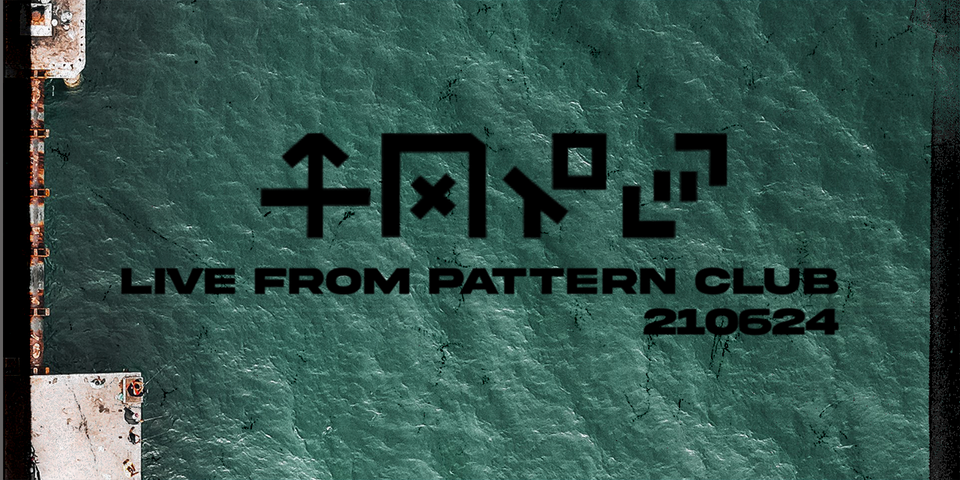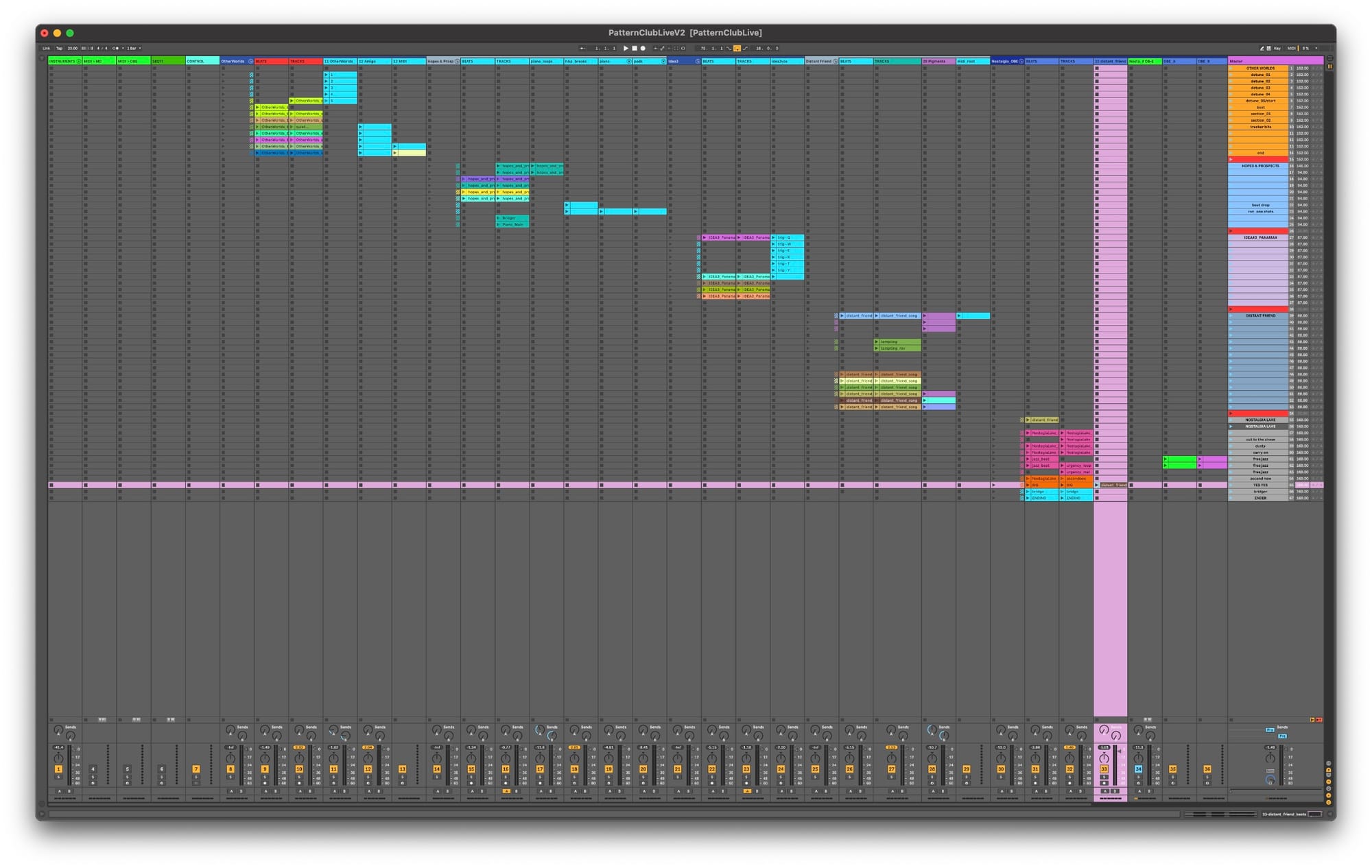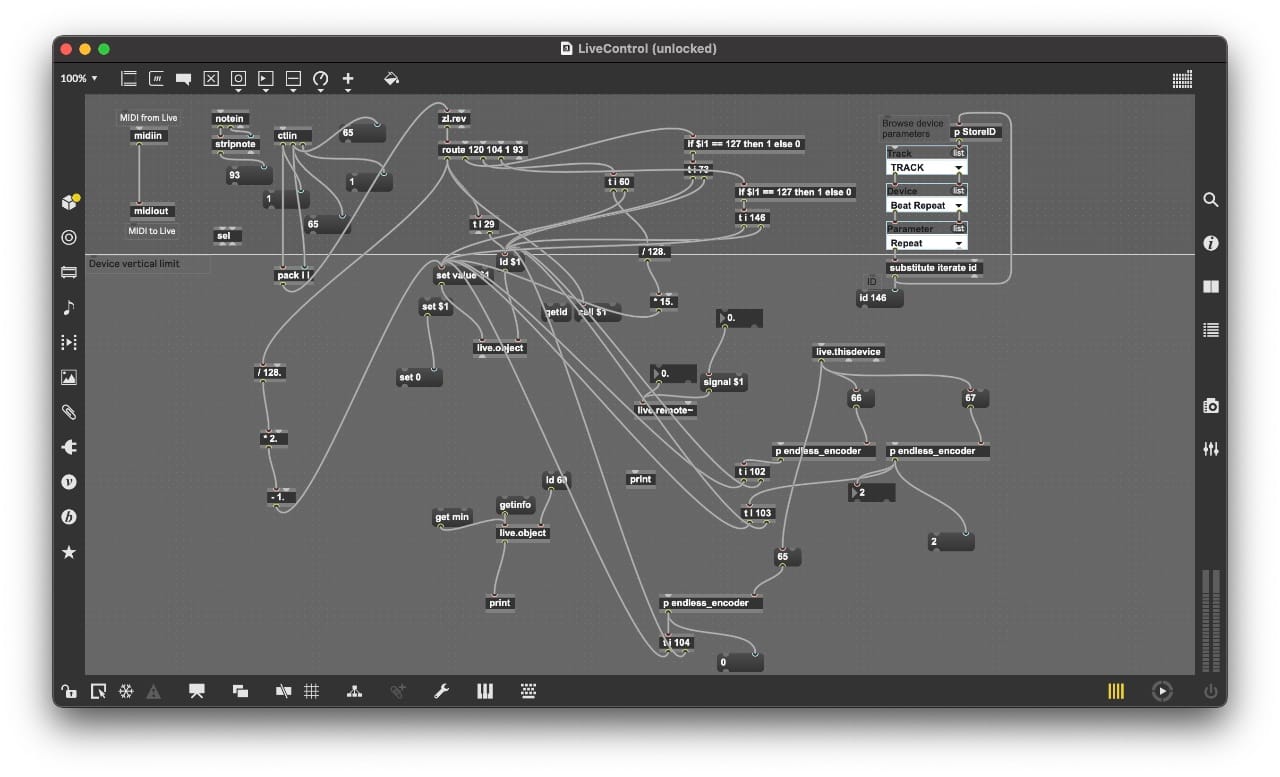Live From Pattern Club

I had a great time finally playing live again at Pattern Club last week. It feels like forever since those 65 shows last autumn, and even longer since the last Polinski live outing. Plus it was the first time that I heard any of my recent tracks at that kind of volume. Always a treat.
Thanks to everybody who came, and thanks in particular to the people who came and said hello. It was the first time meeting a K.N.R.U. reader in real life! And there was a nice bunch of 65daysofstatic fans who had come along too. Cheers.
It was cool sharing a stage with some excellent performers too. I enjoyed it all, but highlights were Lil Data's car horn-sample-based gabba and Yaxu stopping his show mid-set to give everyone a maths lesson. Some classic algorave fare right there.
I managed to get a recording of my show which I'm happy with, so I'm sticking it on bandcamp. Here it is, look:
You can stream it for free, but if you'd like to support The Komoy Noise Research Unit's humble quest to continue making unsubtle bangers, then it's only a fiver (or more if you like) to download and preserve forever on the hard drive of your choice. It also contains a brand new, still very much in-progress song not found anywhere else: 'Hopes & Prospects'.
Tracklist:
- Other Worlds Pts. 1 & 2 (Live From Pattern Club, 210624)
- Hopes & Prospects (Live From Pattern Club, 210624)
- Idea#3_PANAMAX.wav (Live From Pattern Club, 210624)
- Distant Friend, I Love You! (Live From Pattern Club, 210624)
- Nostalgia Lake is Dying Pt. 2 (Live From Pattern Club, 210624)
Enjoy!
THE LIVE SET-UP
Well, I promised to do this so I'm gonna get into it now or I'll never get around to it. After various dead ends, which I'll leave for another day, I ended up playing this using Ableton Live. I'll go through it a track at a time. The whole set looked like this:

It's quite austere as far as these things go, I think. Elegant? Or lazy? Who can say!
From left to right:
- Some soft synths and utility MIDI tracks.
- The Songs. Each song is grouped into however many channel strips it needs and they are also staggered vertically so I move down through the rows as the set progresses.
- Some output busses at the end (not pictured).
OTHER WORLDS PTS. 1
Opening with Other Worlds in its full 14 minute glory was mainly a treat to myself. And also, at 152bpm, it is actually the slowest song here and it's always easier to speed up over the course a set than slow down.
Stems-wise, all the songs are just split into 'beats' (beats) and 'track' (everything else). This is not ideal and if I'd had more time I would have broken down the songs into more components and no doubt pointlessly overcomplicated everything. But also: this way was fine. These stems were further split into smaller audio clips. These clips were mostly set to follow on from one to the next, and so left untouched the song would simply play through seamlessly, but I could choose to skip forward or loop a particular section if I felt like it. Because this song is so long, with extravagant chord progressions that include key changes and actually has more microtonal stuff going on than it probably sounds like, it's not really a great song for on-the-fly chopping and changing.
So the peformance of the first half of Other Worlds was about bringing in some new loops at the beginning, a good old beat-repeat effect on the beats, and some delay/verb sends and separate filters on both beats and track, all controllable via a cute lil' MIDI controller called the Fader Fox DJ3.
FIRST TECHNICAL TANGENT
I managed to grab the Fader Fox DJ3 off eBay for pretty cheap the other week and am still unreasonably pleased with myself for this. HOWEVER, this is a relatively old model and was originally designed for Traktor (DJ software), and isn't quite as easily remappable as generic MIDI controllers are these days. About half the dials are endless, clickable encoders and while some of the buttons send MIDI notes, other buttons send er, that other kind of MIDI control signal that isn't notes or CC. Or SYSEX. I'm not sure what they're sending, tbh. What all this meant is that a significant number of the buttons and dials weren't properly recognised by Ableton Live's built in MIDI learn feature, so I needed to build a Max For Live patch that would read all the MIDI input from the DJ3 and then turn the various controls I wanted to use into something Ableton Live could deal with. This patch was super lazy and messy because I didn't really want to have to make it. It looked like this:

Not my finest work, but it did mean I could use the DJ3's cue buttons as momentary toggles and its endless encoders could cycle through data at a scale of my choosing. And whomst among us can honestly say they have not longed for this kind of MIDI power?
OTHER WORLDS PTS. 2
In the mid-point of the song, I had a few extra drum loops loaded into the Amigo sampler plug-in. I started them looping manually and was then messing with the phase and length of the loops. This plug-in is FILTHY and a great way to make 90s bangers but, to be honest, was wasted here. Got lost in the mix. I think I mostly put this in because I wanted to be able to do something during this part of the song that was more interesting than just twiddling some delay dials.
Later on, once the song settles into those longer chord progressions, there's some MIDI clips sat alongside the track audio that are recreating those patterns and sending them to a soft synth (GForce's OB-E.) The intention here was to give me the ability to fade or filter out the track and manipulate the synth in realtime, moving the song away from 'just pressing play' into something more like 'live performance'. In the moment though, I was too busy dancing and the track stem sounded better the synth. So this was left unused.
HOPES & PROSPECTS
Although Other Worlds is the slowest song, Hopes & Prospects is in the project at 94bpm even though the beats are running doublespeed at 188bpm. This is because the song started off as a slow 94bpm piano piece, but turned into something else whilst it was getting written.
A jump from 152bpm to either 94bpm or 188bpm is quite a lot, so I made a bridging loop. I began with a gentle slow down to 141bpm. 141:94 is the same ratio as 3:2, so running patterns as this ratio presented an interesting way to create unusual melodies and rhythms and segue into 94bpm without it sounding jarring.
This is the kind of thing that is easier to do messing about with patterns inside Max, and a good way to find curious ideas that I would never be able to program manually. But it's also the kind of experimenting that didn't really have space to breathe in this set, so it got rushed through and in the end the effect was kind of lost. Oh well.
Songs with time signatures that are not 4/4 are always a pain point in live performance software that tends to be designed around techno. Songs with shifting time signatures are even more annoying.
Hopes & Prospects switches between 7/4 and 4/4 during its 'chorus' sections. This isn't particularly helpful for looping. It's one bar of 7 and then four bars of 4 so you could get around it by switching to 21/4 for the duration of this section. I didn't do that for a reason I can no longer remember. It might have been when I was considered trying to sync a sequencer of some external gear which I didn't end up doing (?)
What I did in the end was just leave it running in 4/4 and just hook back round to the 4/4 clock when it forgets about the weird time signatures and drops into the beats about half way through. You can hear the song 'freeze' just before the big drop as I do this.
The drop into the big beats is a very gentle kind of generative system based on some basic randomness. The drum pattern stem is sliced up into loops and a different one is getting triggered each time. Similarly, there are half a dozen piano phrases thrown into a sampler and the same for half a dozen pad samples. These each have a 20% chance of triggering each loop, and if either trigger they'll pick a random sample from the pool. This was all just done using Ableton Live's Drum Rack and built-in Random MIDI tool.
IDEA#3_PANAMAX.WAV
For this song the track stem is everything apart from beats and the cut-up vocal samples. I bounced the already-cut-up vocals as a separate stem, dropped that into a sampler and then sliced it up again. Then I made a bunch of MIDI clips that triggered those slices in different patterns and then assigned each clip to a different key on the laptop keyboard. This meant I could 'play' the samples live, switching clips by switching keys.
Additionally, because this song has a more standard format and clear distinctions between its sections, each section was set to loop indefinitely. So my role here was to mess about with vocal samples while slowly moving through the loops of the song. Then once the double-speed beats dropped I mostly messed about with the beat-repeat effect, to mixed success.
DISTANT FRIEND, I LOVE YOU!
There's another soft synth here (another OB-E) that is used to transition between this song and the previous one. They're not the same key, but it's a friendly-enough transition if done carefully. Again, I had several MIDI clips doing different things that I could trigger live, plus some custom loops of the start of the track. Doing the transition involved building up a collage of loops of the new song while fading out or stopping loops from the old song and gradually shifting the tempo. Then, when it's good to go, I launched into the song from when the beat first drops.
And then the remainder of the song is set up so it's mostly dancing about and playing with the delay and verb sends, apart from one of the breakdowns which is set to loop indefinitely just in case I wanted to build anticipation. But in the event I did not want to do that, I was too excited to get to the loud bit.
NOSTALGIA LAKE IS DYING PT 2.
Part one of the song was also cut up and good to go, but it would have been pushing against the upper limit of my set time and, in context, it made much more sense to just cut to the chase and drop straight into part two. In anticipation of this happening, Distant Friend, I Love You! didn't end as it does on record but instead fell into endlessly-looping skittery drum loops from which I could drop into the big Nostalgia Lake sub wobbles.
This drop was a lot of fun, but also helped disguise a bpm drop of 16, which is quite a noticeable amount of bpms. Stopping the beat on purpose and resetting anticipation hopefully meant it didn't feel like the set lost any energy.
After some initial clattering of beats and melody from the album version of the song, the loops drop into a holding pattern of some almost jazz-ish skittery drums.
SECOND TECHNICAL TANGENT
Sitting unused in the Ableton Live project is a custom sequencer built in Max that was sending out MIDI patterns that could be routed to a few different soft synths. This sequencer was designed to make polymetrical patterns. I had dials hooked up to change the length of it from 1 - 16 steps. It used the velocity channel as a probability as to whether that particular step would trigger or not. Elsewhere, MIDI clips for each individual song would trigger in sync with whatever song was currently playing that just fire off a single note. The sequencer used that note to set itself to the key of the song. And so in the sequencer itself, intead of having notes, it had offset values. E.G - a value of 0 would be the root note. 12 would be an octave higher, 7 would be a perfect fifth, etc.
It also did something that, honestly, is too boring even for me to try to type out involving counters and modulos in the Max patch to make sure that, no matter how often I changed the step-length of the sequencer, it would snap back into syncing at the start of the next bar.
Why did I build this? I think that I imagined this part of Nostalgia Lake would be a good place to do something more 'live', more akin to how live coders do things at algoraves, building up patterns on the fly. And wanted to design something that would allow me to do that in a way where I couldn't really make wrong choices tonally. And then I probably thought, well, if I'm building this for just one point in one song, wouldn't it make more sense to try to design it in a way that I could use it everywhere, should I want to?
So that's what I did. And then it didn't sound particularly good. And I realised that it would be much more effective to simply spend a few minutes building a handful of MIDI clips at this point in Nostalgia Lake - ones that I knew would work and sound good, and simply trigger these at this point during the song. It wasn't as complicated and somehow felt like cheating, but it sounded much better. And also - the rest of the set didn't actually need me adding random polymeter patterns all over the place anyway. So all of this was for nothing. Teachable moment? No chance.
THE END
After this part, Nostalgia Lake drops back to various different looping sections, allowing me to have more fun with the beat repeat. I also dropped in some drum loops from Distant Friend... over the top of the very final loops, rolled off the bottom end so the kicks wouldn't get in the way of the main Nostalgia Lake drums, and them kept pitch-shifting that loop all over the place.
And that was pretty much that. Would recommend! It's a lot of fun. I've left some stuff out because this is already pretty long, so if you have any questions, do stick 'em in the comments!
If you'd like to listen to the set, please do. And if you'd like to buy it, that would be even better.

Member discussion